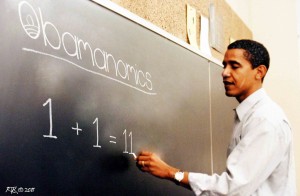 It’s amazing how little President Obama has learned about economics in his four and a half years in the White House. Growth, incentives, tax reform, tax increases, private investment, the middle class, a second great depression, the sequester—all these issues have one thing in common: Obama doesn’t understand their role in our economy.
It’s amazing how little President Obama has learned about economics in his four and a half years in the White House. Growth, incentives, tax reform, tax increases, private investment, the middle class, a second great depression, the sequester—all these issues have one thing in common: Obama doesn’t understand their role in our economy.
Nor does he appear interested in finding out. Members of the now-defunct President’s Council on Jobs and Competitiveness have privately talked about Obama’s economic shallowness. After the 2010 election, he invited four conservative economists to the White House. When former Congressional Budget Office director Douglas Holtz-Eakin broached the subject of the economic cost of Obamacare, the president dismissed it as politics, not economics.
Obama seems oblivious to the feeble recovery his policies have produced since the recession bottomed out in June 2009. The jobless rate is 7.3 percent. But if the millions who’ve dropped out of the job market altogether since Obama took office in January 2009 were counted, the unemployment rate would be 10.8 percent. “In other words, the United States faces a permanently larger pool of jobless Americans,” says the American Enterprise Institute’s James Pethokoukis.
The economy has grown at less than 2 percent during Obama’s presidency and shows few signs of picking up the pace. “We need to grow faster,” he acknowledged last week. “We need more good-paying jobs.” Yet he’s sticking to the same policies that led to stagnation in the first place.
He insists the $821 billion “stimulus” package stopped the “downward spiral and put a floor under the fall.” But the recession was over by June 2009, well before the bulk of the stimulus had been implemented. Instead, the Federal Reserve had flooded the economy with liquidity, and the big banks had been bailed out, before Obama was inaugurated. The crisis had been largely quelled without his help.
There’s another fantasy in Obama’s economic dreams: He’s the savior of a beleaguered middle-class America that hasn’t gained economically in many years. “We also started pushing back against trends that have been battering the middle class for decades,” he said in last week’s speech. The rich got 20 percent of national income in 2012, “while the average worker isn’t seeing any raise at all,” he added. “In fact, that understates the problem.”
It overstates the situation and distorts it. The idea of a faltering middle class has been debunked frequently by AEI’s Pethokoukis. Now he has the Census Bureau to back him up. It pegged “real median household income”—a proxy for middle-class income—as rising during the boom years from 1983 through 2007.
The median income was $51,017 in 2012, close to what it was in 2011 but below the $55,627 level in 2007 (before the recession). The peak was $56,080 in 1999. “The Census Bureau is just tracking pre-tax, pre-transfer, non-fringe-benefit market income,” Pethokoukis wrote. So, the bureau said, median income “does not completely capture the economic well-being of individuals and families.”
Note that household income has fallen in the Obama years, as it did in George W. Bush’s second term. From this, I draw a simple conclusion. Middle-class Americans don’t need to be protected by Obama. They need to be protected from him.
. . . . . . . . . . . . . . . .
Fred Barnes is an executive editor at The Weekly Standard.